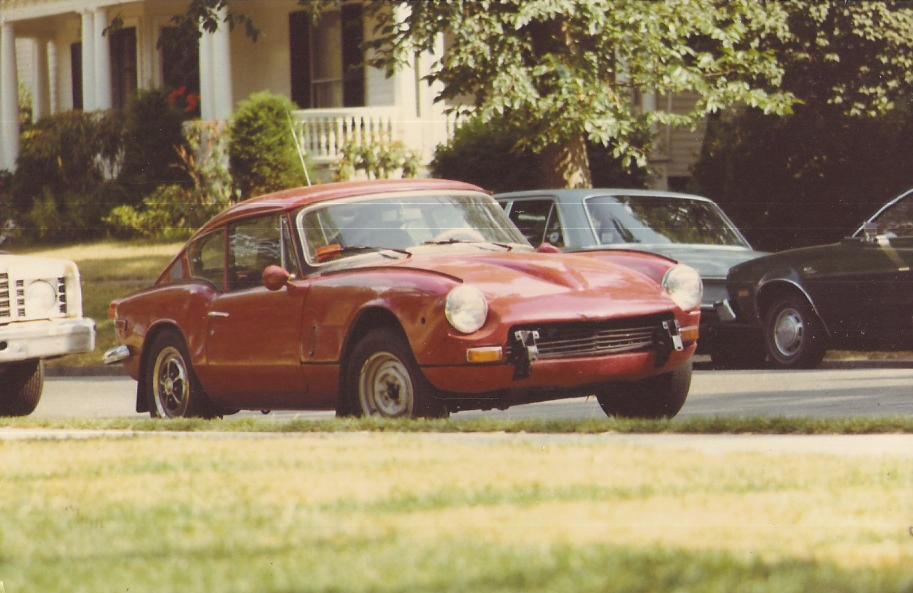Media | Articles
My first car was my worst car—by far
We all have cars that echo in our memories. We likely remember our first cars fondly, and look at them through hormone-impregnated rose-colored glasses. As we get older and purchase cars for more practical reasons, they often become less memorable. If you order that list from most-loved to least-loved, there’s bound to be a car that, due to mediocrity and unreliability, you particularly despised.
In my case, it’s not even close. By a country mile, the worst car I ever owned was, in fact, my first—a 1970 Triumph GT6+. It’s something of a tragic story, really. But it’s also the car that set me on my path to being a car guy.
All through my adolescence, I was a bicycle guy. I found bikes, rebuilt bikes, and rode bikes throughout New England. As I progressed through my senior year of high school in 1976, I was queued up for the natural climax of this activity—to ride cross country the following summer. My mother was livid. She tried the big bribe. “If you don’t go,” she said, “I’ll buy you a car.”
It worked, of course.
I have been a BMW guy since we took in a college student who drove a 2002, and I’ve been forever impressed with what that boxy little German sedan could do. However, even though my mother gave me a budget of $1500—not a trivial amount in 1976—BMW 2002s were still in production, and even used ones were enormously popular. Plus, for all their automotive wiles, they were a little, well, stodgy for an 18-year-old male. So I didn’t run out and buy a 2002.
Marketplace
Buy and sell classics with confidence
Instead, I did what many young men did: I went British. After all, if I wasn’t going to be pedaling cross-country, I’d be hanging around for the summer, and I wanted something to, you know, help attract girls (did I mention that I was an 18-year-old male?). I looked primarily at MGs and Triumphs. I even looked at a well-priced Austin-Healy 3000 Mk3, but—and let’s all laugh together—I didn’t like the lines. Mostly I looked at Spitfires, MGB GT hatchbacks, and MG roadsters, as these had a long production history, creating a ready supply of older cars well within my budget.
And then I saw a 1970 Triumph GT6+ and was immediately smitten. It was a two-seater hatchback like the MGB GT, but instead of the little four-pot, it had a 2.0-liter six-cylinder engine (a de-stroked version of the TR6 motor) and was much quicker than the Spits and Bs I’d been looking at. It had a wood dashboard and Smiths gauges. It looked and felt like a little Jaguar E-Type. Like Frye on Futurama, I did the “shut up and take my money” (or my mother’s money) thing, and for $1500, the GT6 was mine.

There was one problem. Well, there were actually many problems, but there was one immediate problem: The car had a homicidal rear suspension. I need to delineate this from the general rear suspension issues that GT6s have. The early ones had the same swing axles as the Spitfire, which made the rear wheels tuck under during cornering (heaven help you if you lifted off the gas). Mine had the second of three rear suspension designs, with reversed rear A-arms, Rotoflex couplings, and a single transverse leaf spring.
But the immediate issue was that, on my car, the attachment point on the floor where the left rear radius rod (the rear suspension component that affixes the tow-in) had rotted out. Not surprisingly, this caused lethally unstable handling, especially when you nailed the accelerator, which of course, like any red-blooded 18-year-old male, I did as often as possible. So a few days after I bought it, and after a near-miss with a utility pole (the adolescent brain is a frightening thing), I took it to a welder and had the floor fixed.
Initially, the car was great. It served its intended purpose. Mom wasn’t up nights wondering if I was sleeping in a ditch somewhere in North Dakota, and I had a very cool, very visible, very quick little British car. And the previous owner had installed both an 8-Track and a cassette deck (I kid you not), so I had plenty of tunes. To this day, I can’t hear Gary Wright’s Love Is Alive or any of the Eagles’ Greatest Hits without instantly being transported back to the GT6’s cockpit and those Smiths gauges.

I’d enrolled at University of Massachusetts-Amherst for the fall, so I began frequently traversing the 100 miles from Boston to Amherst in the Triumph. The straight sections out Route 2, combined with the sweeping curves on Route 202, were heavenly. It was on the latter that I experienced my first failure. The car’s temperature shot up, and steam began clouding the windshield. I made it to a friend’s house and tried to figure it out. As I said, I’d been a bicycle guy, and a car was just another mechanical system. I could see water streaming out behind a pulley that had a belt on it. I inferred that this was the water pump, and deduced that the bearing and seal must’ve gone bad. I got a ride into town, bought the parts and some antifreeze, borrowed some tools from my friend’s father, and fixed it in his driveway. I can trace my entire automotive repair career back to this single moment.
A water pump is a normal-wear-and-tear part, so I can’t hold it against the car. But it was just the beginning. In the 30 months that I owned the Triumph, I had things break that I’ve never had break on any other car. I had the clutch release fork break on its pivot point, requiring removal of its transmission. Another break—the metal tube that the clutch throwout bearing slides on—required removal of the transmission a second time. The universal joint on one of the rear half-axles ripped out. The driveshaft literally cracked. A contributing factor to some of these failures was likely the fact that much of the GT6’s running gear was inherited from the Spitfire, and it wasn’t designed to take the torque of the larger 6-cylinder mill. For the others, I used to joke that these problems were traceable to the fact that the British used up their steel in World War II, so Spitfires were made from recycled Spitfires. There’s probably a good deal of truth to it.
And those were just the mechanical issues. Of course, there were also the electrical problems. It would be surprising if anyone reading this doesn’t know that vintage British cars have Lucas electrical systems, and that Lucas, due to reputation for failure of its electrical components, became known as “The Prince of Darkness.” It is difficult to exaggerate the electrical problems that the GT6 had. I’d drive it at night and the headlights would spontaneously cut out. I’d drive it in the rain and the wipers would suddenly stop working. You can imagine what fun it was at night in the rain. There were times when I limped it in the breakdown lane until I reached an overpass, and sat and waited until things dried out. (Pour yourself a cold drink, Google “Lucas electrical jokes,” and settle in for a good 15 minutes of laughing. Given my experience with the GT6+, my favorite is, “Lucas didn’t claim to invent darkness, only sudden unanticipated darkness.”)
And the rust. The attachment point of the radius rod was just the beginning. The rocker panels began to dissolve as I watched them. The bottoms of the doors turned into Swiss cheese.
In addition, I was a poor college student (the origin story of many of us who began working on their own cars), and I kept the Triumph running on a shoestring budget. If a tire only had a little of its belts showing, it was still good. This, combined with the car’s weight distribution and suspension geometry, made it likely to try to kill you if you did anything unexpected on anything but a laser-straight road with even a hint of moisture on it. I vividly recall rounding a corner at moderate speeds in the lightest of rain, the car swapping ends, and winding up in someone’s front yard. The girl I was with said, “I’ll walk back to the dorm from here.”
By the fall of my junior year in college—about 2 1/2 years after I’d bought the car—I estimated that the GT6 had run about half the time I’d owned it and was laid up waiting for parts and repairs the rest of the time. I advertised it for sale in the local paper, took it for one last drive on the first date with the lovely woman who would become my wife, and sold it the next day. When Maire Anne tells the story, she says “Cute guy, cute car… I thought I had it made. And then he sold it!” It was better that than having the car serially strand us at the beginning of a serious relationship.
The GT6+ has now been gone 40 years. Whenever anyone talks about how old British cars really weren’t all that bad, I nearly do a spit-take and recount my story. With that said, there’s no question that, as my first car, as the car on which I learned to wrench, and as the car that took me and my wife on our first date, it holds a special place in my heart. But there’s also no question that, repair-wise, being-laid-up-wise, and arriving-home-at-the-end-of-a-tow-hook-wise, it was, by far, the worst car I ever owned.
I’m not the first one to note that GT6s look like little E-Types, and the past few years, prices have come up quite a bit. The days are long gone when pretty, shiny, reportedly rust-free cars languished for six grand. The ’71 and later Kamm-tailed Mk3 cars are perhaps the sleekest, but, as is often the case, it’s the earlier Mk1 cars in the best condition that seem to bring the best money.


I will admit that, in my incessant Craigslist browsing, I’ve been known to type “Triumph GT6” into the search window. However, I still own a dead ’74 Lotus Europa Twin Cam Special, and I have a rule that I can own only one senseless homicidal British car at a time. But if I bought another GT6, I’d be sure to pop in an 8-Track of Eagles Greatest Hits, head west on Route 2, and smile.
And hope the headlights stay on.
***
Rob Siegel has been writing the column The Hack Mechanic™ for BMW CCA Roundel magazine for 30 years. His new book, Just Needs a Recharge: The Hack Mechanic™ Guide to Vintage Air Conditioning, is now available on Amazon. You can also order a personally inscribed copy here.










Absolutly spot on, the GT6 was a very pretty heap of junk. We had one after a TR3 and were shocked by how far the standard had slipped. The drivers seat was designed to cripple any unfortunate who sat in it, the overdrive clutch burnt out regularly, even the splines on the knockons crumbled away. I think the problem was that it was built up from a Spitfire, which was itself a built up Herald so there was no solid base as was the case with the TR series.